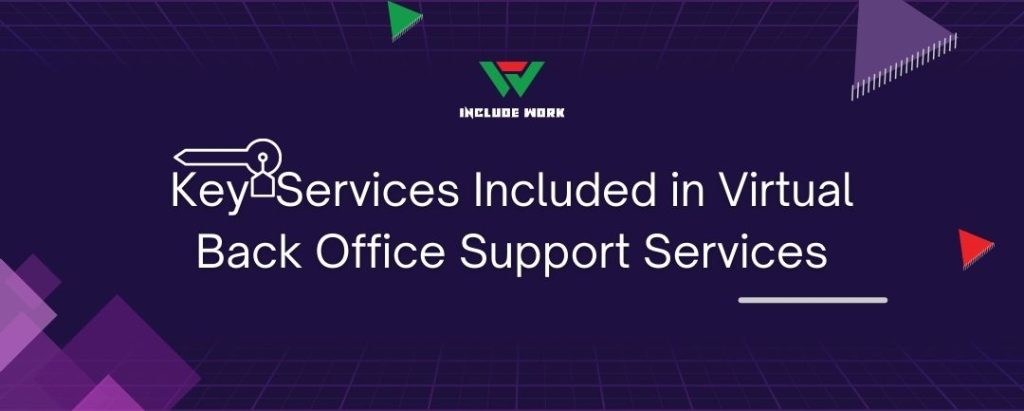In today’s digital era, Virtual Back Office Support Services have emerged as a game-changer for businesses seeking efficiency and scalability. These services provide essential back-office functions remotely, allowing companies to focus on core activities while reducing operational costs. With the rise of remote work and technological advancements, virtual support services are not just an option but a strategic necessity for businesses aiming to thrive in a competitive market. This overview delves into the nature, evolution, and benefits of these services, offering insights into how they can transform your business operations.
Table of Contents
What are Virtual Back Office Support Services?
Virtual Back Office Support Services refer to the remote management of various non-core business operations such as administrative tasks, financial services, human resources, and more. These services are provided by external teams who use digital tools to manage and execute tasks that traditionally required an in-house presence. This approach allows businesses to outsource mundane or complex back-office tasks to specialized professionals who ensure these functions are performed efficiently, securely, and cost-effectively.

By leveraging virtual support services, businesses can:
- Enhance their focus on core business strategies.
- Gain access to expert skills and advanced technologies.
- Reduce overhead costs associated with physical office space and personnel.
These services are flexible and scalable, making them suitable for businesses of all sizes—from startups to established corporations. Whether it’s managing payroll, handling customer inquiries, or processing transactions, virtual back office teams provide the support you need to keep your operations smooth and streamlined.
The Evolution of Virtual Back Office Support Services
The concept of Virtual Back Office Support Services has significantly evolved over the past decade. Initially, businesses outsourced simple tasks like data entry and basic customer service. However, as technology advanced, so did the scope of services offered. Today, these services encompass a wide range of complex functions, including advanced analytics, strategic planning, and specialized consulting.

Key milestones in the evolution of virtual back office support include:
- Technology Integration: The adoption of cloud computing and AI has enabled more sophisticated services, such as real-time data analysis and automated decision-making.
- Global Talent Access: With virtual services, businesses are no longer limited by geographic boundaries and can access top talent from around the world.
- Increased Security Measures: As reliance on virtual services grew, so did the focus on cybersecurity, ensuring that remote operations do not compromise data integrity or business continuity.
This progression has not only increased the efficiency and scope of back office functions but also transformed them into strategic components that contribute significantly to business growth and resilience.
Benefits of Virtual Back Office Support Services
Adopting Virtual Back Office Support Services offers a multitude of advantages that can significantly enhance the operational dynamics and profitability of a business. Here are some of the key benefits:
Cost Efficiency: By outsourcing back-office tasks, companies can reduce costs related to hiring, training, and maintaining in-house staff. Additionally, it minimizes the need for physical office space, which can be a substantial overhead expense.
Scalability: Virtual services are highly scalable, allowing businesses to adjust the level of support based on current needs. This flexibility is particularly beneficial for businesses experiencing seasonal fluctuations or rapid growth.
Access to Expertise: Virtual back office providers often employ specialists with extensive experience and qualifications in specific fields, giving your business access to a higher level of expertise than might be available or affordable locally.

Enhanced Focus on Core Business Functions: With back-office responsibilities handled externally, management can focus more on core business strategies and development, which is crucial for long-term success.
Improved Service Quality: External teams dedicated to back-office tasks are typically equipped with advanced tools and technologies, leading to more efficient, accurate, and timely completion of tasks.
Risk Reduction: Outsourcing can reduce business risks associated with compliance and regulatory requirements by shifting some responsibilities to providers who are experts in these areas and better equipped to keep up with changing laws and regulations.
These benefits collectively contribute to a more streamlined operation, where resources are optimized, and attention is focused on areas that drive business growth and customer satisfaction.
Key Services Included in Virtual Back Office Support Services
Virtual Back Office Support Services encompass a wide array of functions tailored to enhance operational efficiency and support business growth. Here are some of the key services typically offered:
Administrative Assistance: This includes managing schedules, data entry, document preparation and management, and other clerical tasks that support daily business operations.
Financial Services: These services cover bookkeeping, payroll processing, financial reporting, and managing accounts receivable and payable, ensuring that your financial operations are meticulous and timely.
Human Resources: Virtual HR services include employee recruitment, onboarding, payroll management, performance evaluations, and handling employee relations, all crucial for maintaining a productive workforce.

Customer Support: Providing timely and effective customer service, including handling inquiries, complaints, and feedback, as well as managing communication via various channels like email, phone, and live chat.
IT Support: This includes managing IT infrastructure, providing technical support to internal teams, and ensuring cybersecurity measures are up-to-date and effective.
Compliance and Risk Management: Ensuring that the business adheres to laws and regulations, managing risk efficiently, and keeping the operations aligned with legal standards.
These services are not just support functions but are integral components of a strategic approach to business management, enabling companies to operate more efficiently and focus on growth-oriented activities.
How to Implement Virtual Back Office Support Services in Your Business
Implementing Virtual Back Office Support Services effectively requires strategic planning and careful consideration of your business’s specific needs. Here’s a step-by-step guide to help you integrate these services seamlessly:
Assess Your Needs: Begin by identifying the tasks and functions that are time-consuming or do not necessarily require in-house expertise. This assessment will help you understand which services to outsource to achieve maximum efficiency.
Choose the Right Provider: Research potential service providers to ensure they have a proven track record, relevant industry experience, and positive client testimonials. It’s crucial to choose a provider whose capabilities align with your business’s needs.
Set Clear Objectives: Define clear goals and expectations for the services you are outsourcing. This includes detailed descriptions of tasks, deadlines, quality standards, and key performance indicators (KPIs).

Ensure Smooth Integration: Work closely with the provider to integrate their services with your existing processes. This may involve sharing access to certain tools and technologies, and ensuring that their team is adequately trained on your business’s procedures.
Maintain Open Communication: Establish a robust communication plan that ensures ongoing dialogue between your in-house teams and the virtual support staff. Regular updates, feedback sessions, and open lines of communication are essential for addressing any issues swiftly.
Monitor and Evaluate: Continuously monitor the performance of the virtual back office services against the set objectives. Regular evaluations will help you make necessary adjustments and ensure that the services are contributing positively to your business.
By following these steps, you can ensure that the implementation of virtual back office support services not only complements your existing operations but also enhances overall business efficiency and scalability.
Cost Comparison with In-House Support
Here’s a table to illustrate a cost comparison between Virtual Back Office Support Services and in-house support, based on common business expenses:
| Cost Factor | Virtual Back Office Support Services | In-House Support |
|---|---|---|
| Labor Costs | Reduced due to lower salary and benefits expenses. | Higher due to salaries, benefits, and taxes. |
| Operational Expenses | Minimal; no costs for office space, utilities, or physical equipment. | Significant; includes office space, utilities, and equipment. |
| Scalability | High flexibility; easy to scale services up or down as needed. | Limited; scaling up requires significant time and resource investment. |
| Efficiency and Technology | Access to specialized services and advanced technologies. | May require additional investment in technology and training. |
| Training Costs | Provider handles training and development of their staff. | Ongoing training and development costs for staff. |
| Risk Management | Outsourcing can mitigate compliance and operational risks. | In-house management of all risks, requiring robust systems and policies. |
The cost-effectiveness of virtual services does not merely reflect in direct savings but also in the enhanced capability they offer, allowing businesses to invest saved resources into growth and expansion initiatives.
Challenges and Considerations
While Virtual Back Office Support Services offer numerous benefits, there are also challenges and considerations that businesses need to address to maximize their effectiveness:

Communication Barriers: Remote interactions can sometimes lead to miscommunications if not managed properly. Establishing clear communication protocols and using effective collaboration tools are essential to mitigate this risk.
Data Security and Privacy: Outsourcing functions that handle sensitive data requires stringent security measures. It’s crucial to choose providers who comply with relevant data protection regulations and who have robust security practices in place.
Cultural and Time Zone Differences: Working with a team from a different part of the world can present cultural and scheduling challenges. It’s important to foster a culture of understanding and adjust workflows to accommodate different time zones if necessary.
Quality Control: Maintaining high standards of quality can be challenging when tasks are handled externally. Setting up detailed service level agreements (SLAs) and regular quality checks can help ensure that the services meet your business’s standards.
Dependency on Service Providers: Relying on external entities for critical business functions can create a dependency, which might be risky if the service provider faces operational challenges. Developing a contingency plan and maintaining some level of in-house capability can provide a safety net.
Addressing these challenges requires careful planning and ongoing management, but when handled correctly, the benefits of virtual back office support services can far outweigh the potential drawbacks, leading to significant operational improvements and cost savings.
Future Trends in Virtual Back Office Support Services
The landscape of Virtual Back Office Support Services is continuously evolving, influenced by technological advancements and changing business needs. Here are some key trends that are shaping the future of these services:
Increased Automation: Automation technologies like artificial intelligence (AI) and robotic process automation (RPA) are increasingly being integrated into virtual back office services. This shift is expected to enhance efficiency, reduce human error, and speed up the processing of routine tasks.
Focus on Data Security: As businesses become more data-driven and regulatory requirements become stricter, there will be a heightened focus on data security and privacy measures within virtual back office services.
Greater Customization: Businesses are seeking more tailored solutions that fit their specific needs. Service providers are likely to offer more customizable service packages, allowing businesses to select only the services they need.

Expansion of Service Offerings: As the virtual back office sector matures, providers are expanding their service offerings to include more specialized functions such as legal services, advanced analytics, and strategic consulting.
Global Talent Pools: The move towards virtual services will continue to break down geographic barriers, providing businesses access to a global talent pool. This trend is likely to intensify as companies seek to leverage expertise from around the world at competitive costs.
Sustainability Focus: With an increasing global emphasis on sustainability, virtual services are seen as a greener alternative to traditional office setups due to reduced commuter travel and lower office energy consumption.
These trends indicate a promising future for virtual back office services, with potential for significant impact on how businesses operate globally. As these services become more integrated into core business strategies, they will play a critical role in driving operational efficiency and innovation.
Conclusion
Virtual Back Office Support Services are transforming the landscape of business operations, offering scalable, cost-effective, and efficient solutions for managing non-core tasks. By leveraging these services, businesses can focus on strategic growth areas, enhance productivity, and gain competitive advantages in their respective markets. As technology continues to evolve, the scope and quality of these services will only improve, making them an indispensable part of modern business strategies. Moving forward, companies that embrace these virtual services will be better positioned to adapt to market changes and drive business success in the digital age.

